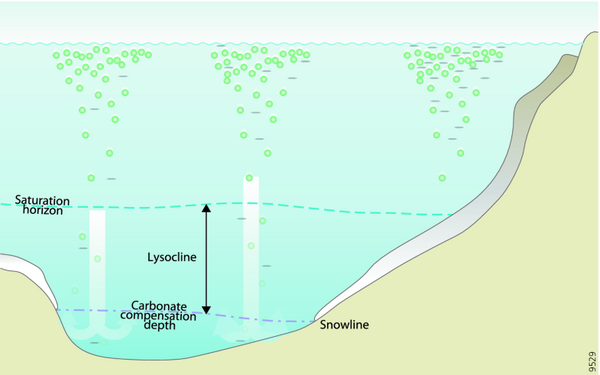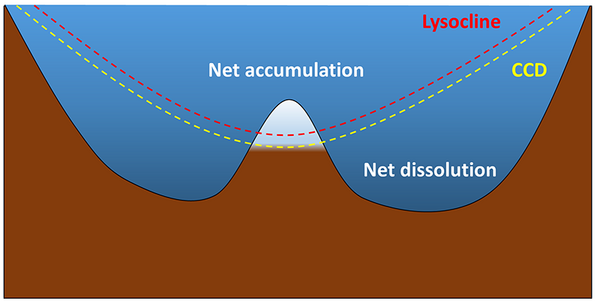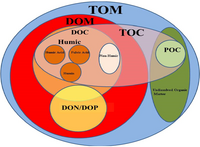عمق تعويض الكربونات
عمق تعويض الكربونات Carbonate compensation depth واختصاره CCD، هو عمق البحر أو المحيط الذي يزداد عنده معدل ذوبان كربونات الكالسيوم إلى الحد، الذي لا يسمح بتراكم أو حفظ أي رواسب أو كائنات كربوناتية على قاع البحر، ويبلغ هذا العمق في المحيط الهادي حوالي 4000 - 5000 متر.[1]
Calcite is the least soluble of these carbonates, so the CCD is normally the compensation depth for calcite. The aragonite compensation depth (ACD) is the compensation depth for aragonitic carbonates. Aragonite is more soluble than calcite, and the aragonite compensation depth is generally shallower than both the calcite compensation depth and the CCD.
استعراض


As shown in the diagram, biogenic calcium carbonate (CaCO3) tests are produced in the photic zone of the oceans (green circles). Upon death, those tests escaping dissolution near the surface settle, along with clay materials. In seawater, a dissolution boundary is formed as a result of temperature, pressure, and depth, and is known as the saturation horizon.[4] Above this horizon, waters are supersaturated and CaCO3 tests are largely preserved. Below it, waters are undersaturated, because of both the increasing solubility with depth and the release of CO2 from organic matter decay, and CaCO3 will dissolve. The sinking velocity of debris is rapid (broad pale arrows), so dissolution occurs primarily at the sediment surface.
At the carbonate compensation depth, the rate of dissolution exactly matches the rate of supply of CaCO3 from above. At steady state this depth, the CCD, is similar to the snowline (the first depth where carbonate-poor sediments occur). The lysocline is the depth interval between the saturation and carbonate compensation depths.[5][2]
Solubility of carbonate
كربونات الكالسيوم هي في الأساس غير قابلة للذوبان في المياه السطحية للبحر، اليوم. وأصداف العوالق الجيرية الميتة التي تغطس إلى مياه أعمق تبقى عملياً بدون تغيير حتى تصل the lysocline حيث تزيد قابلية الذوبان بشكل هائل. وحتى وصولها إلى CCD يكون كل كربونات الكالسيوم قد ذابت حسب هذه المعادلة:
العوالق الجيرية وجسيمات الرواسب يمكن العثور عليهم في عمود الماء فوق CCD. فإذا كان قاع البحر فوق CCD، رواسب القاع قد تتكون من رواسب جيرية تسمى النضح الجيري الذي هو في الأساس نوع من الحجر الجيري أو الطباشير. إذا كان قاع البحر المتعري تحت مستوى CCD، فإن الأصداف الضئيلة من CaCO3 ستذوب قبل وصول هذا المستوى، مما يمنع تراكم رواسب الكربونات. الاستثناء لهذا المبدأ يوجد عندما تتراكم رواسب الكربونات فوق مستوى CCD، مثلما يحدث على طول نتوء منتصف المحيط، وطبقة النضح السيليكوني أو الطمي اللجي المتراكم فوق طبقة الكربونات.[6] وبينما يتمدد قاع البحر، فإن الانكماش الحراري للصفيحة قد يجعل طبقة الكربونات تحت CCD؛ وقد تـُمنـَع طبقة الكربونات من التفاعل الكيميائي مع ماء البحر بسبب الرواسب المتراكمة فوقها.
تغيرات في قيمة CCD
| جزء من سلسلة عن |
| دورة الكربون |
|---|
 |
The exact value of the CCD depends on the solubility of calcium carbonate which is determined by temperature, pressure and the chemical composition of the water – in particular the amount of dissolved CO2 in the water. Calcium carbonate is more soluble at lower temperatures and at higher pressures. It is also more soluble if the concentration of dissolved CO2 is higher. Adding a reactant to the above chemical equation pushes the equilibrium towards the right producing more products: Ca2+ and HCO3−, and consuming more reactants CO2 and calcium carbonate according to Le Chatelier's principle.
At the present time the CCD in the Pacific Ocean is about 4200–4500 metres except beneath the equatorial upwelling zone, where the CCD is about 5000 m. In the temperate and tropical Atlantic Ocean the CCD is at approximately 5000 m. In the Indian Ocean it is intermediate between the Atlantic and the Pacific at approximately 4300 meters. The variation in the depth of the CCD largely results from the length of time since the bottom water has been exposed to the surface; this is called the "age" of the water mass. Thermohaline circulation determines the relative ages of the water in these basins. Because organic material, such as fecal pellets from copepods, sink from the surface waters into deeper water, deep water masses tend to accumulate dissolved carbon dioxide as they age. The oldest water masses have the highest concentrations of CO2 and therefore the shallowest CCD. The CCD is relatively shallow in high latitudes with the exception of the North Atlantic and regions of Southern Ocean where downwelling occurs. This downwelling brings young, surface water with relatively low concentrations of carbon dioxide into the deep ocean, depressing the CCD.
In the geological past the depth of the CCD has shown significant variation. In the Cretaceous through to the Eocene the CCD was much shallower globally than it is today; due to intense volcanic activity during this period atmospheric CO2 concentrations were much higher. Higher concentrations of CO2 resulted in a higher partial pressure of CO2 over the ocean. This greater pressure of atmospheric CO2 leads to increased dissolved CO2 in the ocean mixed surface layer. This effect was somewhat moderated by the deep oceans' elevated temperatures during this period.[7] In the late Eocene the transition from a greenhouse to an icehouse Earth coincided with a deepened CCD.
John Murray investigated and experimented on the dissolution of calcium carbonate and was first to identify the carbonate compensation depth in oceans.[8]
Climate change impacts
Increasing atmospheric concentration of CO2 from combustion of fossil fuels are causing the CCD to rise, with zones of downwelling first being affected.[9] Ocean acidification, which is also caused by increasing carbon dioxide concentrations in the atmosphere, will increase such dissolution and shallow the carbonate compensation depth on timescales of tens to hundreds of years.[10]
Sedimentary ooze
On the sea floors above the carbonate compensation depth, the most commonly found ooze is calcareous ooze; on the sea floors below the carbonate compensation depth, the most commonly found ooze is siliceous ooze. While calcareous ooze mostly consists of Rhizaria, siliceous ooze mostly consists of Radiolaria and Diatom.[11][12]
انظر أيضا
المصادر
- ^ عبد الجليل هويدي، محمد أحمد هيكل (2004). أساسيات الجيولوجيا التاريخية. مكتبة الدار العربية للكتب.
- ^ أ ب Middelburg, Jack J. (2019). "Biogeochemical Processes and Inorganic Carbon Dynamics". Marine Carbon Biogeochemistry. SpringerBriefs in Earth System Sciences. pp. 77–105. doi:10.1007/978-3-030-10822-9_5. ISBN 978-3-030-10821-2. S2CID 104368944.
 Modified material was copied from this source, which is available under a Creative Commons Attribution 4.0 International License.
Modified material was copied from this source, which is available under a Creative Commons Attribution 4.0 International License.
- ^ Webb, Paul (2019) Introduction to Oceanography, Chapter 12: Ocean Sediments, page 273–297, Rebus Community. Updated 2020.
 Modified text was copied from this source, which is available under a Creative Commons Attribution 4.0 International License.
Modified text was copied from this source, which is available under a Creative Commons Attribution 4.0 International License.
- ^ "Ocean acidification due to increasing atmospheric carbon dioxide". The Royal Society.
- ^ Boudreau, Bernard P.; Middelburg, Jack J.; Luo, Yiming (2018). "The role of calcification in carbonate compensation". Nature Geoscience. 11 (12): 894–900. Bibcode:2018NatGe..11..894B. doi:10.1038/s41561-018-0259-5. S2CID 135284130.
- ^ Thurman, Harold., Alan Trujillo. Introductory Oceanography.2004.p151-152
- ^ "Warmer than a Hot Tub: Atlantic Ocean Temperatures Much Higher in the Past". Physorg.com. February 17, 2006.
- ^ Berger, Wolfgang H.; et al. (2016). "Calcite Compensation Depth (CCD)". Encyclopedia of Marine Geosciences. Encyclopedia of Earth Sciences Series. Springer Netherlands. pp. 71–73. doi:10.1007/978-94-007-6238-1_47. ISBN 978-94-007-6238-1.
- ^ Sulpis, Olivier; et al. (October 29, 2018). "Current CaCO3 dissolution at the seafloor caused by anthropogenic CO2". Proceedings of the National Academy of Sciences of the United States of America. 115 (46): 11700–11705. Bibcode:2018PNAS..11511700S. doi:10.1073/pnas.1804250115. PMC 6243283. PMID 30373837.
- ^ Boudreau, Bernard P.; Middelburg, Jack J.; Hofmann, Andreas F.; Meysman, Filip J. R. (2010). "Ongoing transients in carbonate compensation: COMPENSATION TRANSIENTS". Global Biogeochemical Cycles (in الإنجليزية). 24 (4): n/a. doi:10.1029/2009GB003654. S2CID 53062358.
- ^ Johnson, Thomas C.; Hamilton, Edwin L.; Berger, Wolfgang H. (1977-08-01). "Physical properties of calcareous ooze: Control by dissolution at depth". Marine Geology (in الإنجليزية). 24 (4): 259–277. Bibcode:1977MGeol..24..259J. doi:10.1016/0025-3227(77)90071-8. ISSN 0025-3227.
- ^ Webb, Paul. "12.6 Sediment Distribution" (in الإنجليزية).
{{cite journal}}: Cite journal requires|journal=(help)
